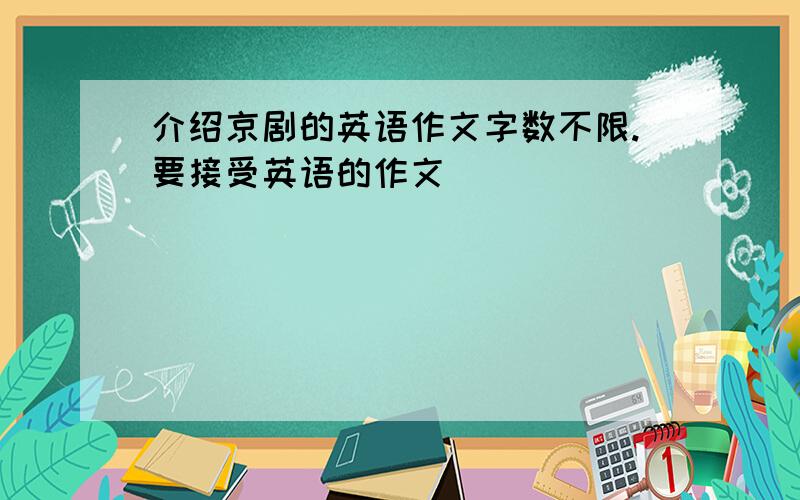介绍京剧的英语作文字数不限.要接受英语的作文
来源:学生作业帮助网 编辑:作业帮 时间:2024/05/02 00:35:35

介绍京剧的英语作文字数不限.要接受英语的作文
介绍京剧的英语作文
字数不限.要接受英语的作文
介绍京剧的英语作文字数不限.要接受英语的作文
Beijing opera or Peking opera (simplified Chinese:京剧; traditional Chinese:京剧; pinyin:Jīngjù) is a form of traditional Chinese theatre which combines music,vocal performance,mime,dance and acrobatics.It arose in the late 18th century and became fully developed and recognized by the mid-19th century.[1] The form was extremely popular in the Qing Dynasty court and has come to be regarded as one of the cultural treasures of China.[2] Major performance troupes are based in Beijing and Tianjin in the north,and Shanghai in the south.[3] The art form is also enjoyed in Taiwan,where it is known as Guoju (国剧; pinyin:Guójù).It has also spread to other countries such as the United States and Japan.[4]
Beijing opera features four main types of performers.Performing troupes often have several of each variety,as well as numerous secondary and tertiary performers.With their elaborate and colorful costumes,performers are the only focal points on Beijing opera's characteristically sparse stage.They utilize the skills of speech,song,dance,and combat in movements that are symbolic and suggestive,rather than realistic.Above all else,the skill of performers is evaluated according to the beauty of their movements.Performers also adhere to a variety of stylistic conventions that help audiences navigate the plot of the production.[5] The layers of meaning within each movement must be expressed in time with music.The music of Beijing opera can be divided into the Xipi and Erhuang styles.Melodies include arias,fixed-tune melodies,and percussion patterns.[6] The repertoire of Beijing opera includes over 1,400 works,which are based on Chinese history,folklore,and,increasingly,contemporary life.[7]
In recent years,Beijing opera has attempted numerous reforms in response to sagging audience numbers.These reforms,which include improving performance quality,adapting new performance elements,and performing new and original plays,have met with mixed success.Some Western works have been adopted as new plays,but a lack of funding and an adverse political climate have left Beijing opera's fate uncertain as the form enters the 21st century
这个网站很好,你以后想了解其他的东西的英文解释都可以来查.
我也刚从初三毕业,英语还不错,推荐你常上这个网站,
With its fascinating and artistic accompanying music, singing and costumes, the Peking Opera is China's national opera. Full of Chinese cultural facts, the opera presents the audience with an encyclop...
全部展开
With its fascinating and artistic accompanying music, singing and costumes, the Peking Opera is China's national opera. Full of Chinese cultural facts, the opera presents the audience with an encyclopedia of Chinese culture, as well as unfolding stories, beautiful paintings, exquisite costumes, graceful gestures and martial arts. Since Peking Opera enjoys a higher reputation than other local operas, almost every province in China has more than one Peking Opera troupes. Opera is so popular among Chinese people, especially seniors, that even "Peking Opera Month" has been declared.
Peking Opera has a 200-year-long history. Its main melodies originated from Xipi and Erhuang in Anhui and Hubei respectively and, over time, techniques from many other local operas were incorporated.
It is believed that Peking Opera gradually came into being after 1790 when the famous four Anhui opera troupes came to Beijing. Peking Opera underwent fast development during the reign of Emperor Qianlong and the notorious Empress Dowager Cixi under the imperial patron, eventually becoming more accessible to the common people.
In ancient times, Peking Opera was performed mostly on stage in the open air, teahouses or temple courtyards. Since the orchestra played loudly, the performers developed a piercing style of song that could be heard by everyone. The costumes were a garish collection of sharply contrasting colors to stand out on the dim stage illuminated only by oil lamps. Peking Opera is a harmonious combination of the Grand Opera, ballet and acrobatics, consisting of dance, dialogue, monologues, martial arts and mime.
The Peking Opera band mainly consists of an orchestra and percussion band. The former frequently accompanies peaceful scenes while the latter provides the right atmosphere for battle scenes. The commonly used percussion instruments include castanets, drums, bells and cymbals. One person usually plays the castanets and drum simultaneously, which conduct the entire band. The orchestral instruments include the Erhu, Huqin, Yueqin, Sheng (reed pipe), Pipa (lute) and other instruments. The band usually sits on the left side of the stage.
收起